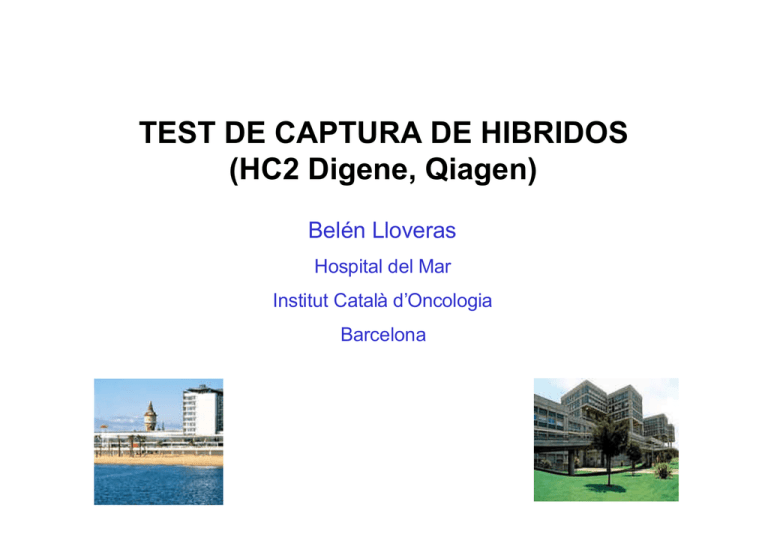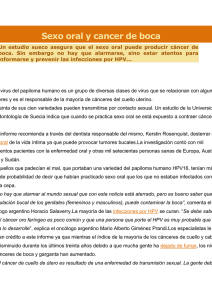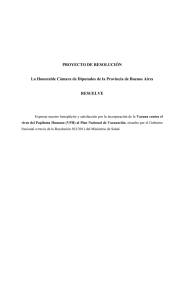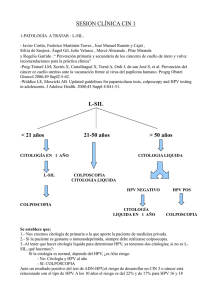Test de captura de híbridos (HC2 Digene, Qiagen)
Anuncio

TEST DE CAPTURA DE HIBRIDOS (HC2 Digene, Qiagen) Belén Lloveras Hospital del Mar Institut Català d’Oncologia Barcelona TEST DE CAPTURA DE HIBRIDOS (HC 2) • • • • Aspectos técnicos Estudios realizados con HC2 Experiencia propia Discusión FDA Approves Expanded Use of HPV Test The Food and Drug Administration (FDA) today approved expanded use of a laboratory test to detect the presence in women of human papillomavirus (HPV), one of the most common sexually transmitted infections. There are more than 100 types of HPVs. The test, the HC2 High-Risk HPV DNA Test, manufactured by Digene Corp., of Gaithersburg, Md., can identify 13 of the high-risk types associated with the development of cervical cancer. The HPV DNA test does not test for cancer, but for the HPV viruses that can cause cell changes in the cervix. If left untreated, these changes can eventually lead to cancer in some women. FDA initially approved the HPV DNA test in March 2000 for testing women who had abnormal Pap test results to determine whether they needed to be referred for further examination. The new indication allows the test to be used for screening, in conjunction with the Pap test, of women over age 30 for HPV infection. It should be used along with the Pap test, a complete medical history and an evaluation of other risk factors to help physicians determine what kind of follow-up is necessary. “Knowing whether or not a woman is infected with high-risk HPV is added information that will help physicians detect and treat early cell changes that might eventually lead to cervical cancer,” said FDA Commissioner Mark B. McClellan, M.D., Ph.D. “FDA is committed to bringing safe and effective new technologies to the market quickly.” Up to 20 percent of the sexually active U.S. population is believed to be infected with HPV at any one time. Most women who become infected with HPV are able to eradicate the virus and suffer no apparent long-term consequences to their health. But a few women develop a persistent infection that can eventually lead to precancerous changes in the cervix. The HPV DNA test, like the Pap test, is performed by collecting cells from the cervix and then sending them to a laboratory for analysis. The test detects high-risk types of HPV in cell DNA even before there are any conclusive visible changes to the cervical cells. Women who have normal Pap test results and no HPV infection are at very low risk (0.2%) for developing cervical cancer. Women who have an abnormal Pap test and a positive HPV test are at higher risk (6%-7% or greater) of developing cervical cancer if not treated. FDA approved the expanded use of the test based on published literature describing studies of a cross section of women with normal and abnormal Pap test results who tested positive or negative for high -risk types of HPV. FDA also took into account additional input from professional societies, FDA advisory panel members and other interested parties in arriving at a decision. The HPV DNA test is not intended to substitute for regular Pap screening. Nor is it intended to screen women under 30 who have normal Pap tests. Although the rate of HPV infection in this group is high, most infections are short- HC2 VPH VPH PHYLOGENETIC CLASSIFICATION EPIDEMIOLOGIC CLASSIFICATION HIGH RISK HIGH RISK LOW RISK 16, 18, 31, 33, 35, 70 39, 45, 51, 52, 56, 58, 59, 68, 82, 26, 53, 66 LOW RISK 73 6, 11, 40, 42, 43, 44 54, 61, 72, 81, CP6108 Muñoz et al. New Engl J Med 2003;348:518-27 PHYLOGENETIC CLASSIFICATION EPIDEMIOLOGIC CLASSIFICATION HIGH RISK HIGH RISK LOW RISK 16, 18, 31, 33, 35, 70 39, 45, 51, 52, 56, 58, 59, 68, 82, 26, 53, 66 LOW RISK 73 6, 11, 40, 42, 43, 44 54, 61, 72, 81, CP6108 Muñoz et al. New Engl J Med 2003;348:518-27 FIG. 1. Schematic representation of the locations of the different general primer sets (MY 09/11, GP51/61, and SPF) on the HPV genome. The circular HPV DNA genome is represented by a single line, and boxes show the positions of the various early (E) and late (L) genes. Within the L1 region, the positions of the amplification targets as well as the expected amplimer sizes for each of the primer sets are indicated. CAPTURA DE HIBRIDOS HC2 DIGENE Ac anti-hibrido + PA Sonda RNA DNA-HPV Ac anti-hibrido Sustrato luminiscente Desnaturalización ? Hibridación ? Captura ? Ac + PA ? Sustrato ? Reacción qluminiscente RLU/CO > 1 = POSITIVO ? Lectura 5 SONDAS HPV BAJO RIESGO (A) : 6 / 11 / 42 / 43 / 44 13 SONDAS HPV ALTO RIESGO (B) : 16 / 18 / 31/ 33 / 35 / 39 / 45 / 51 / 52 / 56 / 58 / 59 / 68 LAVADOR DE PLACAS DIGENE PROCESO DEL HC2 LUMINOMETRO DIGENE LAVADO Y DETECCIÓN PROCESAMIENTO DE DATOS INFORME DE RESULTADOS INFORME DE RESULTADOS Tablas N = 124 REPRODUCIBILIDAD INTRALABORATORIO 93.5 % HC2 • Reproducibilidad • Formato kit • Fácil introducción en laboratorios de citología • Estudios clínicos APLICACIONES DIAGNOSTICAS DEL TEST DE HPV CRIBADO SELECCIÓN DE ASC-US (TRIAGE) SEGUIMIENTO POST-TRATAMIENTO CONTROL DE CALIDAD Comparison of three management strategies for patients with atypical squamous cells of undetermined significance: Baseline results from a randomized trial. D.Solomon, M. Schiffman, R.Tarone. JNCI 2001;93:293-9 ASCUS LSIL TRIAGE STUDY (National Cancer Institute, Bethesda) • 2.000.000 ASCUS / año en U.S.A. • ALTS (nov 96 ? dic 98): – estudio randomizado y multicentrico (4) – objetivo: comparar la sensibilidad y especificidad de 3 estrategias: 1. Colposcopia / Biopsia 2. HPV-HC2 + citologia líquida : HPV+ ? Colposcopia Cito=HSIL ? Colposcopia 3. Repetición de la citologia ALTS: RESULTADOS Análisis de 3488 mujeres con ASCUS: • Colposcopia 1163 100 % colposcopia • HPV-HC2 + citol líq 1161 56 % colposcopia • Repetición citologia 8 % colposcopia LSIL n=1572 1164 ALTS: RESULTADOS Los datos de la colposcopia inmediata definen la prevalencia de enfermedad: 25.4 % Normal (sin biopsia) 46.9 % Normal (con biopsia) 1.7 % Atipia 14.5 % CIN 1 6.3 % CIN 2 11.4 % HSIL 5.1 % CIN 3 72.3 % ALTS: RESULTADOS CITOLOGIA vs. HPV Resultados HPV (HC2) Citologia Missing Neg ASCUS LSIL HSIL-CIN 2 HSIL-CIN 3 Total Neg 9 934 541 67 7 0 Miss 3 73 38 38 9 3 Pos 6 453 555 525 191 36 Total 18 1460 1134 630 207 39 1558 164 1766 3488 ALTS: RESULTADOS HISTOLOGIA QC Hist Colposc HPV triage Neg Atipia esc CIN 1 CIN 2 CIN 3 539 20 167 72 59 131 237 10 111 59 77 Total 857 494 Conservador 136 19 2 16 12 44 93 56 ALTS: RESULTADOS HISTOLOGIA QC Hist Colposc HPV triage Neg Atipia esc CIN 1 CIN 2 CIN 3 539 20 167 72 59 131 237 10 111 59 77 Total 857 494 ? 42% Conservador 136 19 2 16 12 44 93 56 1992-2002: 15 estudios con 5454 mujeres seguidas por ASCUS con citologia, test VPH, colposcopia y biopsia HPV test (cualquier) HPV (HC2) Repetición citol Sens* Espec* 84.4% 94.8% 81.8% 72.9% 67.3% 57.6% * para CIN2 + 34% 24295 381 10% 2.7% Kjaer et al. Cancer Res 2006 20-29 años N= 8656 40-50 años N= 1578 Kjaer et al. 2006 Kjaer et al. 2006 Riesgo absoluto de desarrollar CIN3 + en mujeres jóvenes (<30) con citologia normal y dos tests de HPV en un intervalo de 2 años. Cancer treatment reviews 2004 The results of this overview suggest that there might be a role for a HPV DNA test at the follow up period. Actually, the sensitivity of HPV testing in primary diagnosis of CIN seems to be similar to that in prediction of treatment failure. Some treatment failures may have a negative HPV test in the presence of an abnormal cytology. Therefore a combined cytological evaluation together with a HPV test may increase the safety of the follow up surveillance. This is the case in one study,where the sensitivity of HPV testing in the first postoperative visit was 44.7%, the corresponding sensitivity of cytology was 46.8% but HPV testing was positive in 11 cases with a negative smear at this visit giving a combined sensitivity of 70.2%. EL VPH COMO FACTOR PREDICTIVO DE PERSISTENCIA/RECIDIVA TRAS CONIZACION CERVICAL POR LESION ESCAMOSA INTRAEPITELIAL DE ALTO GRADO (H-SIL) ME FERNANDEZ MONTOLI, B LLOVERAS Y COL. AEPCC 2008 • 311 pacientes sometidas a conización cervical con asa diatérmica desde enero de 1996 a diciembre de 2006. • criterio de inclusión el diagnóstico histológico de CIN 2-3 en la conización. • HPV-AR pre y post conización, a los 6 meses de la intervención mediante HC2. • Se valoran: edad, el estado inmunológico, el resultado anatomopatológico (número de cuadrantes, afectación de márgenes), HPV-AR y carga viral pre y post conización. EL VPH COMO FACTOR PREDICTIVO DE PERSISTENCIA/RECIDIVA TRAS CONIZACION CERVICAL POR LESION ESCAMOSA INTRAEPITELIAL DE ALTO GRADO (H-SIL) ME FERNANDEZ MONTOLI, B LLOVERAS Y COL. AEPCC 2008 Las variables categóricas se comparan mediante test de ?2, y las continuas mediante T test y test de Mann–Whitney. El grado de asociación entre las variables y el riesgo de persistencia/recidiva se mide mediante regresión logística. Los modelos se ajustan por edad en el momento de la conización EL VPH COMO FACTOR PREDICTIVO DE PERSISTENCIA/RECIDIVA TRAS CONIZACION CERVICAL POR LESION ESCAMOSA INTRAEPITELIAL DE ALTO GRADO (H-SIL) ME FERNANDEZ MONTOLI, B LLOVERAS Y COL. AEPCC 2008 • La frecuencia global de persistencia/recidiva es del 25%. • Si se considera el estado inmunológico, la prevalencia es del 19% en pacientes no inmunodeprimidas y del 62% en pacientes inmunodeprimidas (Infección por VIH, trasplante de órganos). • La mujeres inmunodeprimidas tienen un riesgo 5.58 veces superior de presentar enfermedad residual/recidiva al de las que no lo son (P<0.001, OR (IC:95%) = 5.58 ( 2.03-15.3) EL VPH COMO FACTOR PREDICTIVO DE PERSISTENCIA/RECIDIVA TRAS CONIZACION CERVICAL POR LESION ESCAMOSA INTRAEPITELIAL DE ALTO GRADO (H-SIL) ME FERNANDEZ MONTOLI, B LLOVERAS Y COL. AEPCC 2008 • La positividad de HPV-AR post conización incrementa el riesgo de persistencia/recidiva 17.56 veces (P=0.06, OR (IC 95%) (1.51-10.95) • Los casos con persistencia/recidiva presentan una carga viral significativamente superior (P<0.001). No hay diferencias en los valores de carga viral previa al cono entre pacientes con o sin enfermedad residual HPV-AR post conización y enfermedad residual enfermedad residual % casos 100 50 0 HPV- HPV+ No Persistencia Persistencia EL VPH COMO FACTOR PREDICTIVO DE PERSISTENCIA/RECIDIVA TRAS CONIZACION CERVICAL POR LESION ESCAMOSA INTRAEPITELIAL DE ALTO GRADO (H-SIL) ME FERNANDEZ MONTOLI, B LLOVERAS Y COL. AEPCC 2008 • La afectación del margen endocervical de la pieza de conización se asocia a riesgo de persistencia 5.03 veces superior al de los casos no afectos (P=0.004, OR (IC 95%) = 5.03 (1.68-15.03) • Una edad superior a 35 años aumenta el riesgo de persistencia 2.38 veces, pero con resultado cercano a significación (P=0.59). • No se han observado diferencias significativas en el número de cuadrantes afectos en el espécimen de conización ni en HPV-AR o carga viral pre-conización. CITOLOGIA LIQUIDA + HC2 ASC-US CRIBADO CRIBADO =ASC-US N = 1000 N = 250 NORMAL N = 125 TEST HPV HOSPITAL citol CITOLOGIA COLPOSCOPIA /BIOPSIA TEST HPV N = 125 TEST DE VPH EN EL CONTROL DE CALIDAD EN CITOLOGIA CITOLOGIA NEGATIVA / VPH + REVISIÓN DE LA CITOLOGIA DONDE SE ESCONDE EL VPH?? CITOLOGIA NEGATIVA I VPH + HUB 2002 MATERIAL 77 citologias (74 pacientes) 32 biopsias (41.5%) RESULTADOS ASC-US ASC-H LSIL 12 (15%) 1 (1.2%) 2 (2.4%) ASC-H ASC-H ASC-US CIN I CAPTURA DE HIBRIDOS (HC2) VENTAJAS: • Formato de kit • Reproducible •Sensibilidad “clínica” adecuada • Posibilidad de automatizar LIMITACIONES: • No tipifica • Elevado nº muestras CAPTURA DE HIBRIDOS (HC2) APLICACIONES • ASCUS • CRIBADO • SEGUIMIENTO POST TRATAMIENTO • CONTROL DE CALIDAD HPV HPV HPV HPV HPV HPV Esto no es un coilocito Esto no es un coilocito


